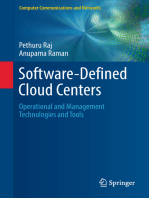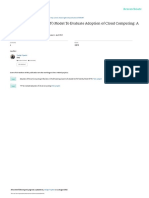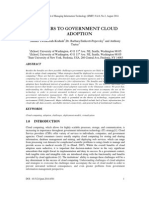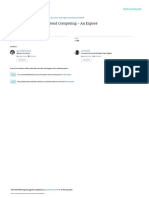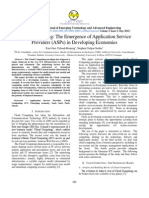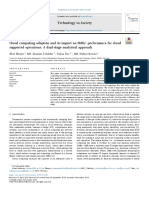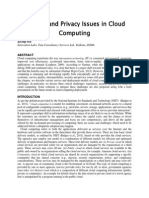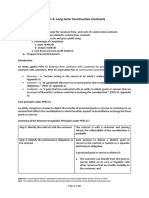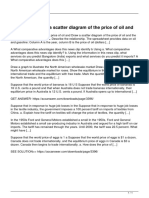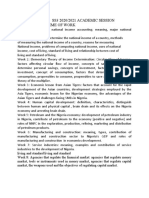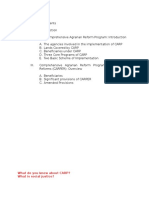Professional Documents
Culture Documents
Strategic Cloud Computing Framework A Case Study of South African IT Professionals
Original Title
Copyright
Available Formats
Share this document
Did you find this document useful?
Is this content inappropriate?
Report this DocumentCopyright:
Available Formats
Strategic Cloud Computing Framework A Case Study of South African IT Professionals
Copyright:
Available Formats
Volume 5, Issue 8, August – 2020 International Journal of Innovative Science and Research Technology
ISSN No:-2456-2165
Strategic Cloud Computing Framework:
A Case Study of South African IT Professionals
Andrian Wilby Twala Ray M Kekwaletswe
Graduate School of Business Leadership Graduate School of Business Leadership
University of South Africa University of South Africa
Midrand, South Africa Midrand, South Africa
Abstract:- In a challenging business environment, should cloud computing be strategically adopted and use in
organizations are striving to stay competitive. Cloud the context of South African organizations. This paper
computing is changing the way IT services is being developed a framework known as strategic cloud computing
provided and managed. Cloud computing is becoming framework. In this study strategic cloud computing
more relevant in that the benefits of cloud computing inferences to the organizational strategy in that cloud
include reducing infrastructure and maintenance costs, computing adoption and use is in line with the strategic
increasing operational efficiencies, availability and goals of an organization.
flexibility. However, like any other technology, both
strategically and operationally, the organizations are A. Cloud computing attraction
not very confident in adoption and using it. Therefore, Cloud computing brings a paradigm shift in how we
in an attempt to help South African organizations to view capital and operational costs in IT. Cloud computing
leverage off the benefits of cloud computing. This paper promises numerous benefits such as reducing infrastructure
focuses on how cloud computing may be strategically and maintenance costs, increasing operational efficiencies,
adopted and use in South Africa from the context of improving availability and flexibility of resources [2].
individual Information Technology Professionals. To Organizations are considering cloud computing as an
achieve these South African organizations require a alternative technology that will be used as a cost-effective
means to adopt and use cloud computing. To this point, strategy for managing IT costs.
the contribution of this paper is a framework, based on
Contingency Theory, Stakeholder Theory and Varia[2] position cloud computing as a solution that
Technology-Organization-Environment Framework offers benefits such as the fast provision of hardware, pay as
(TOE), that South African organization can use to you use model, shared resources and visualization. Authors
strategically position cloud computing as preferred Marston, Li, Bandyopadhyay, Zhang and Ghalsasi[3]
technology in a uniformed and coordinated manner. concurs that cloud computing is appealing because it offers
This study applies interpretivism philosophy and case cost-saving, the flexibility of resources and pay as you use
study to understand the cloud computing adoption and of resources.
use in South African organizations. The study
participants were purposefully selected based on their B. Cloud computing trends
knowledge, experience and views on cloud computing. Cisco[4] report reveals an increase in the use of cloud
The main contribution of this paper is the strategic computing data centres. The report reveals that interest in
cloud computing framework that can be used by cloud computing has grown significantly. Gartner estimated
decision-makers to strategically adopt and use cloud spend on cloud computing in the next five years to reach $1
computing in a uniformed and coordinated manner in trillion[5]. It is stated by Gartner forecasts that the IT spends
South African organizations. in South Africa, estimate that by 2019 more than R303
billion will have been spent on cloud computing[6].
Keywords:- Cloud Computing, St ak e hol de r,
Contingency, TOE Framework, South Africa, IT C. Cloud strategic alignment
Professionals. As more organizations begin to moving to cloud
computing. There is a need to strategically position cloud
I. INTRODUCTION computing in an organization. In this study, we would
propose a framework that can be used by South African
Information technology (IT) has been used for a long organizations to strategically position cloud computing as a
time in support activities in organizations. Due to the current preferred technology. The framework is based on
economic conditions in South Africa, organizations are stakeholder theory, contingency theory and technology-
looking into alternative technology such as cloud computing organization-environment framework.
as a way of saving on IT resources, free up existing
resources and maintenance costs. This paper consists of eight sections. In section two
cloud computing will be defined and discussed. Section
Cloud computing is defined as the internet-based three will discuss the theoretical framework. Section four
computing in which users can share IT resources in a secure explains the conceptual research framework. Section five
and efficient system [1]. This research paper is about how would discuss the research methodology. Section six would
IJISRT20AUG305 www.ijisrt.com 375
Volume 5, Issue 8, August – 2020 International Journal of Innovative Science and Research Technology
ISSN No:-2456-2165
discuss the study findings. Section seven explains the final (NIST) which defined cloud computing as “a model for
research framework. The last section gives a study enabling convenient, on-demand network access to a shared
conclusion. pool of configurable computing resources(as an example,
networks, servers, storage, applications, and services) that
II. SURVEY OF SCHOLARSHIP can be rapidly provisioned and released with minimal
management effort or service provider interaction” [8].
This section provides an overview of the literature
review conducted as part of this study. The next subsection As shown in Figure 1, cloud computing is composed of
discusses the definitions of cloud computing. five essential characteristics namely broad network access,
rapid elasticity, measured service, on-demand self-service
A. Understanding Cloud Computing and resource pooling. Three service models namely
This section introduces cloud computing and the Software as a Service (SaaS), Platform as a Service(PaaS)
benefits of cloud computing. Cloud computing is considered and Infrastructure as a Service(IaaS) [9]. Cloud computing
as a paradigm shift in the way IT resources are being paid consists of four deployment models, such as public cloud,
for and delivered[7]. The most commonly cited definition is private cloud, hybrid cloud and community cloud [3].
by the National Institute of Standard and Technology
Fig 1:- NIST model of cloud computing[8]
The organization considers various business and Furthermore, the environment in which an
technical factors before the adoption and use of cloud organization operates is important in the decision-making
computing. Cloud computing offers various benefits such as process. Jain and Pandey[11] in their study draw attention to
cost-saving, improved operational efficiencies, immediate the cloud computing environment. The study highlighted the
access to IT resources, business agility and scalability, potential risks and potential benefits of adoption and use of
accessibility of resources from anywhere at any time[2]. cloud computing. The study found that the benefits of cloud
computing offset the risks.
Despite the numerous advantages of cloud computing,
there are hindering factors that need to be addressed by In their study Kumar et al[12], they identified
organizations, such as security, costs, regulations, contract business-related issues with regards to cloud computing.
lock-in, data privacy, compliance challenges and cloud These included the policies, cloud computing strategy and
service failure which might prevent management of technology implementation. Pardeshi[13] highlighted the
organization from adopting and using cloud computing. need to have a strategy for cloud computing. The strategy
will provide an alternative solution to the financial crisis of
B. Contingencies for cloud computing an organization.
At the organizational level, the decision to adoption
and use cloud computing is centered on the contingencies Cloud computing is a new business environment. A
such as organization strategy, structure and size, and study by Kaisler, Money and Cohen[14] came up with a
external environment such as various regulations. decision framework that was meant to assist the decision-
makers when considering to adopt and use the cloud
In research conducted by Blanton, Watson and computing and to determine which cloud computing
Moody[10], the authors used the constructs of contingency solution meets their organization cloud computing
theory such as external environment, strategy and structure requirements.
to understand how an organization would require its
structure to create strategies to improve their stance in the Therefore, this study utilized the elements of
market. contingency theory to conceptualize the study’s framework.
IJISRT20AUG305 www.ijisrt.com 376
Volume 5, Issue 8, August – 2020 International Journal of Innovative Science and Research Technology
ISSN No:-2456-2165
C. Stakeholders for cloud computing D. Factors of cloud computing
Stakeholders influence cloud computing adoption and This section discusses the factors that are important in
use. Therefore, understanding the roles and goals of cloud computing adoption and use There have been several
stakeholders in the adoption and use of cloud computing is studies related to factors of cloud computing. Most of these
very crucial for the organizations. studies have used the TOE framework to list and discuss
factors.
As discussed by Yuvaraj[15], cloud computing can
bring value to different stakeholders. The study concluded A study by Priyadarshinee[17] used the TOE
that the main reason for cloud adoption is the benefits such framework to predict that factors of cloud computing in
as improved services, availability of services, ease of use Indian organizations. The study found factors such as
and costs reduction. security risks, trust, technology innovation and management
style have a significant influence on the adoption of cloud
In the cloud computing context, the relationships computing.
between stakeholders are slightly changing. The NIST
presented a reference architecture of cloud computing Another study by Senyo, Effah and Addae[18] was
clearly defines a group of actors. The main stakeholders are conducted to determine cloud computing factors using the
the cloud provider, who supply the cloud services to TOE as a research lenses. The study found that,
interested parties. The cloud consumer is the stakeholder technological factors such as relative advantage and security
that subscribe or use cloud services. The cloud brokers or as the most significant. Organizational factors such as top
enablers who facilitates the delivery of cloud services management and technology readiness. The environmental
between provider and customer. The cloud auditors conduct factors such as competitive pressure and trade partners were
an independent assessment of cloud services. found to be significant.
The study by Haung[16] explored the implementation Table 1 below shows previous studies on factors of IT
of IT resources from stakeholder’s perspective. The study adoption and usage using the TOE framework. The most
found that the implementation project can succeed when prominent factors were relative advantage, complexity,
stakeholder interests are considered and coordinated by top compatibility and security in a technological context. Top
management. The study concluded that stakeholders have an management support, cost-saving, technology competence
influence when planning for a cloud computing project. were most important in an organizational context.
Government regulation and competitor pressure were most
Therefore, this study utilized the elements of important in the environmental context.
stakeholder theory to conceptualize the study’s framework.
Category Factors
Relative advantage [19],[20],[21]
Complexity [19],[20],[22], [23]
Technology
Compatibility[19],[20],[22]
Security [19],[22], [24], [25]
Top management support[19],[20], [21],[26]
Organization Cost-saving [27], [28], [2]
Technology competence[23], [29]
Government regulation [24],[28]
Environment
Competition pressure[30],[31]
Table 1:- Previous studies using TOE framework
Therefore, this study utilized the elements of TOE framework to conceptualize the study’s framework.
III. THEORETICAL FRAMEWORK A. Contingency Theory
The basis of contingency theory is that there is no best
This study is underpinned by the Contingency Theory, way of organizing and managing an organization. According
Stakeholder Theory and Technology-Organization- to Donaldson[32], contingency theory is defined as a
Environment (TOE) framework. The three theories are variable that moderates the aspects of organizational
explained briefly. characteristics on organizational performance.
IJISRT20AUG305 www.ijisrt.com 377
Volume 5, Issue 8, August – 2020 International Journal of Innovative Science and Research Technology
ISSN No:-2456-2165
As shown in Figure 2, the contingency theory has The stakeholder theory is relevant for this paper as it
components such as organizational structure, organizational identifies the key stakeholders when deciding on the cloud
strategy and organization performance[33]. computing adoption and use.
Fig 2:- Contingency Theory[10] Fig 3:- Stakeholder Theory[34]
The elements of contingency theory are briefly C. Technology-Organization-Environment
explained: The TOE framework, as depicted in figure 4, below
Organizational structure refers to that, there is “no one was developed by Tornatzky et al, [35] in 1990. The
best way” meaning that no single structure is optimal for framework examines the process of how an organization
all the organization goes about adopting and implementing technological
Organizational strategy refers to the core of the innovations. The adoption and implementation process is
organization. The long-term direction of an organization. believed to be largely influenced by three contexts namely
Organizational Environmental influences refer to the technological factors, organizational factors and
external pressures or government regulations that the environmental factors
organization need to conform to.
Organizational performance refers to defined past,
present and future accomplishment on the given task
against pre-set standards of accuracy and completeness.
The contingency theory is relevant for this paper as it
gives the contingency variables for cloud computing
adoption and use.
B. Stakeholder Theory
The stakeholder theory was introduced by
Freeman[34] in the year 1984. The stakeholder theory is
used to understand the relationship between management
and stakeholders. Stakeholders are defined as “any group or
individual that can affect or is affected by the achievements
of the organization’s objectives.
Fig 4:- Technology, Organization, Environment[35]
The stakeholder theory describes the value that is
being created when stakeholders are working together. The
The components of the TOE are briefly discussed as
theory originally presented the stakeholder model as a map
follows:
in which an organization is the hub of a wheel and
Technology factors refer to the existing and new
stakeholders are at the end of spokes around the rim. The
technology that is owned by the organization
stakeholder map is depicted in figure 3, below.
Organization factors refer to the organizational
characteristics such as organization size, organization
Stakeholders can influence organizations in several
structure and top management support of the
ways, the importance of stakeholders depends on the
organization
organization’s management perceptions and the stakeholder
Environment factors refer to external factors that may
influence will be more or less proactive or reactive.
influence the adoption of technology such as the
regulatory environment, competitive pressure and
industry pressure in which the organization
IJISRT20AUG305 www.ijisrt.com 378
Volume 5, Issue 8, August – 2020 International Journal of Innovative Science and Research Technology
ISSN No:-2456-2165
The TOE is relevant for this paper as the decision to
adopt and implement cloud computing is influenced by Figure 5 graphically presents the conceptual research
technology, organization and environment factors framework that guided this study and enables the research
questions to be answered. The framework consists of five
IV. CONCEPTUAL RESEARCH FRAMEWORK elements of contingencies elements, technological elements,
organizational elements stakeholder elements and
This section sets out the proposed the research environmental elements. The elements will be briefly
conceptual framework. The framework is underpinned by discussed.
the Contingency Theory, Stakeholder Theory and
Technology-Organization-Environment Framework (TOE).
Fig 5:- Initial Conceptual Research Framework (Researcher)
The table 2 below outlines the elements of the conceptual research framework:
Framework/Theory/Model Description
Stakeholder theory Stakeholder:
Employees
Third parties
Customers
Contingency Theory Contingency variables:
Organisation strategy
External environment factors
Characteristics of an organisation such as structure and size
Technology-organization-environment Technology context:
framework “Ease of use” of cloud computing
Characteristics of cloud computing with regards to the complexity
Characteristics of cloud computing with regards to compatibility
Organisation context:
Role of top management support
Cloud computing policies and procedures
Environment context:
An external environment such as government regulations
Competition within the industry
Table 2:- Elements of a conceptual research framework
IJISRT20AUG305 www.ijisrt.com 379
Volume 5, Issue 8, August – 2020 International Journal of Innovative Science and Research Technology
ISSN No:-2456-2165
V. METHODOLOGY D. Research Design
This section describes how the study was conducted.
Collis and Hussey[36] defined methodology as the According to Mouton[44], a research design is a plan or
“overall approach to the entire process of the research blueprint of how you intend conducting the research. The
study”. The research methodology needs to tie to the study section outlines the unit of analysis, study population,
ontology and epistemology in that “given the nature of sampling technique and size.
cloud computing South African reality and to show how the
generate new knowledge that is consistent with the Unit of Analysis
epistemology and ontology[37]. The unit of analysis describes the level at which the
research is performed. Babbie[45] defines the “unit of
A. Research Philosophy analysis” as the “what” or “who,” being studied. The paper
According to Lincoln and Guba[38], research analysis individual IT professionals in South Africa. That is,
philosophy refers to the set of beliefs that guide the the unit of analysis is the individuals.
researcher’s assumption. The study followed an
interpretivism philosophy to study cloud computing Study Population
adoption and use. According to Creswell[39], an A study population is an aggregation of individuals,
interpretative philosophy uses the participants' views of the events and other interesting elements[46]. It is from a
situation being examined. population where a sample is selected. The study population
influences the sampling process[47].
The study used the interpretivism to solicit IT
professional’s views, opinions, perceptions and experiences The population was limited to the individuals who are
with regards to cloud computing adoption and use. The working in the IT sector in South Africa.
interpretivism paradigm gave an alternative way of
understanding cloud computing adoption and use from the Sampling Method
individual’s point of view. According to Bryman and Bell[42] sampling technique
is how sample size is selected from the study population. A
B. Research Approach sampling method can be classified as probability and non-
There are two types of research approaches; namely, probability.
qualitative and quantitative. This study followed a
qualitative research approach. According to Creswell[39], This study used the purposive sampling technique to
qualitative researchers use a language of cases and contexts, select the participants who are knowledgeable with cloud
to understand the concept of the phenomenon. A qualitative computing to provide the information required by the
approach is defined as the analysis of data such as interview guide. According to Creswell[39], purposive
information from the proceedings of the interview[40]. sampling focuses on a particular characteristic of a
population that of interest. The participants of the study
This study used the qualitative research approach to were chosen base on their experiences and perceptions on
gather the empirical data from individual IT professionals cloud computing adoption and use from their own
with views, experiences and knowledge of cloud computing perspectives.
especially with regards to the South African organization
context. Study Participants
The participants of this study included individuals IT
C. Research Strategy professionals who have knowledge, experiences and views
Saunders et al [41]defined research strategy as “the about cloud computing. The exact number of participants
general plan of how the researcher will go about answering cannot be determined in qualitative research before the
the research questions”. Another definition by Bryman and study is carried out. The researcher has specially selected
Bell[42] defined a research strategy as “a general orientation participants who can contribute to the research subject and
to the conduct of research”. who are willing to share their experiences.
The study adopted a case study as a research strategy. E. Data Collection methods
Creswell[39] defines a case study as the study of an issue Kothari[48] described data collection as a systematic
explored through one or more cases within a bounded gathering of information that addresses the research problem
system. Yin[43], defines case study research as a practical using various techniques. The primary data was collected
review that probes a current event within a day-to-day through interviews. Data collection associated with
environment when the limitations between the event and qualitative research will be unstructured using open-ended,
environment are not well defined. A case study based on a semi-structured and unstructured interviews.
purposive sampling technique was utilized to gather
empirical data through individual participants views, Therefore, an interview guide was developed in order
opinions and experience about cloud computing. The to address the research objectives. The study collected
participants were chosen to give an alternative way of primary data through semi-structured interviews with
understanding cloud computing adoption and use from the individuals from IT professionals such as managers,
individual’s point of view. professionals, experts and consultants.
IJISRT20AUG305 www.ijisrt.com 380
Volume 5, Issue 8, August – 2020 International Journal of Innovative Science and Research Technology
ISSN No:-2456-2165
The semi-structured interviews were carried out at the themes were developed based on the study research
place agreed with participants. According to Baker and objectives. Tracy [51]states that once the data is gathered
Edwards[49], a sample of 12 and 60 are the guideline for a the researcher will categorize the data according to the
qualitative study. This was well within a minimum themes identified. Creswell[39] suggest that data analysis in
saturation point to draw inferences. qualitative research consists of preparing and organizing the
data for analysis, reducing the data into themes through a
F. Data Analysis process of coding and condensing codes.
Yin [43] recommends that for optimal benefit from
data analysis, the researcher methodically arranges and sets The theoretical thematic analysis helps the researcher
up the data to be analyzed. The face to face interviews was to interpret the research data based on research questions
electronically recorded and then transcribed for data analysis through which the theoretical lens affects these research
purposes. questions.
The data analysis was qualitative in nature. An Table 3 below summarizes the research philosophy,
appropriate qualitative analysis method such thematic research approach, research strategy, research design, data
analysis was used to analyze and interpret data [50]. The collection methods and data analysis.
Details Description
Research Paradigm Interpretivism paradigm
Research Approach Qualitative research approach
Research Strategy Case Study
Research Design
Unit of analysis The unit of analysis is the individuals
Study population Individual IT professionals
Sampling technique The purposive sampling
Semi-structured interviews were used to collect primary data to give an in-
Data collection methods
depth analysis
Data analysis A thematic analysis was used to analyse the data.
Table 3:- Research Methodology
VI. DISCUSSION OF FINDINGS with the study by Scholtz, Govender & Gomez[24], where
the study found factors such as regulation requirements,
The goal of this study was to determine how cloud availability and data privacy as important factors when
computing could be strategically adopted and used in the moving to the cloud computing.
South African organization's context. Semi-structured
interviews were conducted using a purposive sampling Cloud computing is seen as an idea that would bring
technique. Four themes were identified to answer the down the costs of hardware, by providing immediate access
research questions namely understanding cloud computing, to hardware resources, without capital investments [53]. The
contingencies of cloud computing, stakeholders and factors public cloud is the most popular choice of cloud deployment
of cloud computing. and the software as a service is the main concept behind
cloud computing regardless of deployment model.
A. Theme1: Understanding cloud computing
The purpose of theme one was to understand cloud The findings concur with the findings of a study by
computing through the eyes of IT professionals. Cloud Erdogmus[54], where the study found that Software as a
computing refers to a model that allows cloud users to log service is considered to be the main concept behind cloud
into computer resources such as servers, network and data computing regardless of deployment model.
storage capacities via the internet [1].
B. Theme 2: Contingencies for cloud computing
The findings indicated that the participant has a good The purpose of theme two was to analyze the practical
knowledge of cloud computing. The understanding of cloud and theoretical contingencies for cloud computing. The
computing is consistent with the literature[1],[8],[52]. paper analyzed contingencies such as organizational
Moving to the cloud should be a planned decision. The strategy, organizational structure and external environment.
requirements include the regulation requirements, choosing
the right type of cloud service model, staff competencies, The organizational strategy was seen as important
and top management support. Participants managed to list elements when adopting and using cloud computing. The
all the requirements to be taken into account before moving strategy aligned the technology towards organizational
to the cloud computing environment. The findings concur goals. The findings were in line with a study by Mital,
IJISRT20AUG305 www.ijisrt.com 381
Volume 5, Issue 8, August – 2020 International Journal of Innovative Science and Research Technology
ISSN No:-2456-2165
Pearce and Robinson [55] where the authors defined the computing factors. The TOE framework was put forward by
organizational strategy as a plan for interacting with the DePietro[58].
environment to achieve the organizational goals.
The following factors enable the cloud computing
In the environmental context, the factors such as adoption and use were identified such as relative advantage,
competition pressure, government policy, power outages top management support, organization size, compatibility
and network bandwidth costs seem to influence the adoption and complexity.
and use of cloud computing. The business environment in
South Africa is not the same as developed countries with The relative advantage of cloud computing technology
regards to politics and culture. The infrastructure is unique emerged to be the reason why organizations are adopting
to the South African environment, competition pressure and using cloud computing technology such to reduce the
plays a significant role in the adoption and use of cloud cost of IT, ease of use, reliability, improved IT services. The
computing. Other factors that influence the adoption of findings concur with the literature that relative advantage
cloud computing are the stable power availability and the influences usage and adoption of cloud computing [18],[22]
costs of connectivity such as broadband and bandwidth costs
seem to be restricting the update of cloud computing by The top management support will influence the
organizations in South Africa. adoption and use of cloud computing in an organization.
The findings concur with the study of Talmizie, Ibrahim, &
According to Borgman et al[56], the size of an Chuprat[26]on assessing the support of top management in
organization can be a challenge the could facilitate the the adoption and use of cloud computing
adoption and use of cloud computing. This construct gave a
mixed-view as to whether the structure and size of an The large organizations it is very difficult to adopt to
organization might influence the adoption and use of cloud the new system such as cloud computing and abandon their
computing. The empirical evidence shows that small and current systems. The cloud computing benefits such as cost-
medium-sized organization tend to be more creative and saving, operational efficiencies, immediate access to IT
innovative when adopting and using cloud computing. resources, accessible from anywhere at any time[2], are the
reasons for organizations switch from their in-house system
C. Theme 3: Stakeholders for cloud computing to a cloud-based system.
The purpose of theme three was to identify the
stakeholders for cloud computing. The findings from the Complexity is the degree to which an innovation is
interviews showed that there was a general consensus on perceived as relatively difficult to understand and use.
stakeholder involvement. Complexity influences the adoption and use of cloud
computing[22],[20].
The participant highlighted the importance of
stakeholder management when deciding on adoption and Compatibility refers to the degree to which cloud
use of cloud computing within an organization. Thus, the computing is perceived as consistent with the current
relevant stakeholder should be identified and involved situation in organizations is exhibited. Technical
earlier in the adoption and use of cloud computing. compatibility influences the adoption and use of cloud
computing [22],[20].
The findings of the study concur with the literature. A
study by Hambrick and Cannella[57] stressed the VII. STRATEGIC CLOUD COMPUTING
importance of involving people early on in development and FRAMEWORK
debate of strategic options.
This section outlines the proposed strategic cloud
The findings further show that the role of stakeholders computing framework. The framework was developed by
in organization decision-making is gaining more and more triangulating from the literature review and the research
attention. findings. The new elements from empirical findings were
incorporated into the framework.
D. Theme 4:Factors of cloud computing
The main objective of theme four was to examine the Figure 6 below, depicts the strategic cloud computing
factors of cloud computing adoption and use. Most of the framework. The elements from strategic cloud computing
studies used the TOE framework to identify cloud are described in table 4:
IJISRT20AUG305 www.ijisrt.com 382
Volume 5, Issue 8, August – 2020 International Journal of Innovative Science and Research Technology
ISSN No:-2456-2165
Fig 6:- Strategic cloud computing framework (Researcher)
Table 4 below contextualise the elements of the strategic cloud computing framework:
Framework/Theory/Model Description
Strategic perspective The strategic intent of moving to cloud computing was defined
Identify which workloads to move to the cloud
Determine stakeholders, management and employees who will be involved in
assessing cloud.
Determine the deployment models and the services from the cloud.
Stakeholder theory Stakeholder:
Employees
Third parties
Customers
Contingency Theory Contingency variables:
Organisation strategy
External environment factors
Characteristics of an organisation such as structure and size
Technology-organization-environment Technology context:
framework “Ease of use” of cloud computing
Characteristics of cloud computing with regards to the complexity
Characteristics of cloud computing with regards to compatibility
Organisation context:
Role of top management support
Cloud computing policies and procedures
Environment context:
An external environment such as government regulations and Competition
within the industry
Table 4:- Elements of the strategic cloud computing framework
IJISRT20AUG305 www.ijisrt.com 383
Volume 5, Issue 8, August – 2020 International Journal of Innovative Science and Research Technology
ISSN No:-2456-2165
VIII. CONCLUSION [6]. C. STAMFORD, “Gartner Forecasts IT Spending in
South Africa Will Grow 3.9% in 2019,” 2019.
The aim of this paper was to develop a strategic cloud https://www.gartner.com/en/newsroom/press-
computing framework, that organizations can undertake in releases/2019-07-24-gartner-forecasts-it-spending-in-
order to strategically position cloud computing. This was south-africa-will-gr (accessed Apr. 29, 2020).
done by identifying how cloud computing manifest in the [7]. S. Marston, Z. Li, S. Bandyopadhyay, J. Zhang, and
South African context, the cloud computing contingencies A. Ghalsasi, “Cloud computing - The business
and the factors that might influence its adoption and use. A perspective,” Decis. Support Syst., vol. 51, no. 1, pp.
systematic literature review was used to gather relevant 176–189, 2011, doi: 10.1016/j.dss.2010.12.006.
information and the empirical data was critically analyzed in [8]. P. Mell and T. Grance, “The NIST Definition of
order to identify knowledge gaps and fill them. Cloud Computing Recommendations of the National
Institute of Standards and Technology,” Natl. Inst.
Findings show that available related to the adoption Stand. Technol. Inf. Technol. Lab., vol. 145, p. 7,
and use of cloud computing is mostly at the organizational 2011, doi: 10.1136/emj.2010.096966.
level, but none are in the context of individual information [9]. S. Mathew, “Implementation of Cloud Computing in
technology professionals. This paper brings the individual’s Education - A Revolution,” Int. J. Comput. Theory
point of view on how cloud computing can be adopted and Eng., vol. 4, no. 3, pp. 473–475, 2012, doi:
use in an organization. There is a need for a strategic cloud 10.7763/IJCTE.2012.V4.511.
computing framework in the context of individual IT [10]. J. E. Blanton, H. J. Watson, and J. Moody, “Toward a
professionals that would help to strategically position cloud Better Understanding of Information Technology
computing in the organization in a coordinated manner. The Organization: A Comparative Case Study,” MIS Q.,
framework identified five components that are necessary to vol. 16, no. 4, p. 531, 1992, doi: 10.2307/249735.
achieve the research objectives. [11]. A. Jain and U. S. Pandey, “Role of cloud computing
in higher education,” Int. J. Adv. Res. Comput. Sci.
This research adds value by giving individuals a voice, Softw. Eng., vol. 3, no. 7, p. pp 966-972, 2013.
in which individual experiences, views and opinions on how [12]. B. Li and S. Kumar, “Should You Kill or Embrace
cloud computing can be adopted and used in an Your Competitor: Cloud Service and Competition
organization. The interpretivism philosophy stance was used Strategy,” Prod. Oper. Manag., 2018, doi:
to give an alternative way of understanding cloud computing 10.1111/poms.12843.
adoption and use from the individual’s point of view. [13]. V. H. Pardeshi, “Cloud Computing for Higher
Education Institutes: Architecture, Strategy and
Finally, with the strategic cloud computing framework Recommendations for Effective Adaptation,”
produced from this study. The framework will contribute to Procedia Econ. Financ., vol. 11, no. 14, pp. 589–599,
practitioners with the decision making or be used as a 2014, doi: 10.1016/S2212-5671(14)00224-X.
guideline in how to address the adoption and use of cloud [14]. S. Kaisler, W. H. Money, and S. J. Cohen, “A
computing sensitively to the context in which it takes place. Decision Framework for Cloud Computing,” 2012
45th Hawaii Int. Conf. Syst. Sci., pp. 1553–1562,
REFERENCES 2012, doi: 10.1109/HICSS.2012.52.
[15]. M. Yuvaraj, “Perception of cloud computing in
[1]. B. Hayes, “Cloud computing,” Commun. ACM, vol. developing countries,” Libr. Rev., 2016, doi:
51, no. 7, p. 9, Jul. 2008, doi: 10.1108/LR-02-2015-0015.
10.1145/1364782.1364786. [16]. L. K. Huang, “Exploring factors affecting top
[2]. J. Varia, “Migrating your existing applications to the management support of IT implementation: a
AWS cloud,” A Phase Driven Approach to Cloud stakeholders’ perspective in hospital,” J. Inf. Technol.
Migr., 2010. Manag., vol. XXVI, no. 1, pp. 31–45, 2015, [Online].
[3]. S. Marston, Z. Li, S. Bandyopadhyay, J. Zhang, and Available: http://jitm.ubalt.edu/XXVI-1/article3.pdf.
A. Ghalsasi, “Cloud computing - The business [17]. P. Priyadarshinee, R. D. Raut, M. Kumar, and B. B.
perspective,” Decis. Support Syst., vol. 51, no. 1, pp. Gardas, “Computers in Human Behavior
176–189, Apr. 2011, doi: 10.1016/j.dss.2010.12.006. Understanding and predicting the determinants of
[4]. Cisco, “Cisco Global Cloud Index : Forecast and cloud computing adoption : A two-staged hybrid SEM
Methodology , 2014–2019,” White Paper, 2014. - Neural networks approach,” vol. 76, 2017, doi:
http://www.cisco.com/en/US/solutions/collateral/ns34 10.1016/j.chb.2017.07.027.
1/ns525/ns537/ns705/ns1175/Cloud_Index_White_Pa [18]. P. K. Senyo et al., “Factors influencing cloud
per.html#wp9000816 (accessed Aug. 28, 2017). computing adoption for e-government implementation
[5]. C. STAMFORD, “Gartner Says Global IT Spending in developing countries,” J. Syst. Inf. Technol., 2016,
to Grow 0.6% in 2019,” 2019. doi: 10.1108/JEIM-09-2014-0094.
https://www.gartner.com/en/newsroom/press- [19]. P. K. Senyo, J. Effah, and E. Addae, “Preliminary
releases/2019-04-17-gartner-says-global-it-spending- insight into cloud computing adoption in a developing
to-grow-1-1-percent-i#targetText=The shift of country,” J. Enterp. Inf. Manag., 2016, doi:
enterprise IT,from %24399 billion in 2018. (accessed 10.1108/JEIM-09-2014-0094.
Apr. 29, 2020).
IJISRT20AUG305 www.ijisrt.com 384
Volume 5, Issue 8, August – 2020 International Journal of Innovative Science and Research Technology
ISSN No:-2456-2165
[20]. T. Oliveira, M. Thomas, and M. Espadanal, [33]. N. S. Umanath, “The concept of contingency beyond
“Assessing the determinants of cloud computing ‘It depends’: Illustrations from IS research stream,”
adoption: An analysis of the manufacturing and Inf. Manag., 2003, doi: 10.1016/S0378-
services sectors,” Inf. Manag., vol. 51, no. 5, pp. 497– 7206(02)00080-0.
510, Jul. 2014, doi: 10.1016/j.im.2014.03.006. [34]. R. E. Freeman, Strategic Management: A Stakeholder
[21]. C. Low, Y. Chen, and M. Wu, Understanding the Approach, vol. 1. 1984.
determinants of cloud computing adoption, vol. 27, [35]. L. G. Tornatzky, M. Fleischer, and A. K. Chakrabarti,
no. 4. 2013. The processes of technological innovation. Lexington
[22]. H. Gangwar, H. Date, and R. Ramaswamy, Books, 1990.
“Understanding determinants of cloud computing [36]. J. Collis and R. Hussey, Business research: A
adoption using an integrated TAM - TOE model practical guide for undergraduate and postgraduate
Introduction,” J. Enterp. Inf. Manag., vol. 28, no. 3, students. 2013.
pp. 250–275, 2013, doi: 10.1108/JEIM-08-2013-0065. [37]. R. Weber, “The rhetoric of positivism versus
[23]. W. Klug, “Factors Affecting Cloud Computing interpretivism: A personal view,” Mater. Relig., 2004,
Adoption Among Universities,” Issues Inf. Syst., vol. doi: Editorial.
16, no. 3, pp. 1–10, 2015. [38]. Y. Lincoln, S. Lynham, and E. Guba, “Paradigmatic
[24]. B. Scholtz, J. Govender, and J. M. Gomez, “Technical controversies, contradictions, and emerging
and Environmental Factors Affecting Cloud confluences, revisited,” Denzin HK, Lincoln YS. …,
Computing Adoption in the South African Public 2003.
Sector,” CONF-IRM 2016 Proc., 2016, Accessed: [39]. J. W. Creswell, Research design: Qualitative,
Mar. 24, 2020. [Online]. Available: quantitative, and mixed methods approaches. 4th
http://aisel.aisnet.org/confirm2016. Edition. 2014.
[25]. K. Van Der Schyff and K. Krauss, “Higher Education [40]. A. Bhattacherjee, Social Science Research:
Cloud Computing in South Africa: Towards Principles, Methods, and Practices - viewcontent.cgi.
Understanding Trust and Adoption issues,” South 2012.
African Comput. J., vol. 53, Dec. 2014, doi: [41]. M. Saunders, P. Lewis, and A. Thornhill, Research
10.18489/sacj.v55i0.254. Method For Business Students Seventh Edition. 2016.
[26]. M. Talmizie, R. Ibrahim, and S. Chuprat, [42]. A. Bryman and E. Bell, “Business Research
“ScienceDirect ScienceDirect A Review on Cloud Methods,” Methods, vol. 3, no. 1, p. 595, 2007, doi:
Computing Acceptance Factors,” vol. 00, 2018, doi: 10.4135/9780857028044.
10.1016/j.procs.2017.12.200. [43]. R. K. Yin, Qualitative research from start to finish.
[27]. M. Odeh, G. -Perez, and A. & Warwick, “Cloud 2016.
Computing Adoption at Higher Education Institutions [44]. J. Mouton, “How to succeed in your masters and
in Developing Countries: A Qualitative Investigation doctoral studies: SA guide and research book,” 2005.
of Main Enablers and Barriers,” Int. J. Inf. Educ. Accessed: Jul. 13, 2020. [Online]. Available:
Technol., vol. 7, no. 12, pp. 921–927, 2017, doi: https://www.vanschaik.com/book/4e95949a91b0f.
10.18178/ijiet.2017.7.12.996. [45]. E. Babbie, The practice of social research.
[28]. M. Willett and R. Von Solms, “Cloud-based Email Wadsworth Cengage, 2013.
Adoption at Higher Education Institutions in South [46]. B. Fawcett and J. Hearn, Researching others:
Africa.,” J. Int. Technol. Inf. Manag., vol. 23, no. 2, Epistemology, experience, standpoints and
pp. 17–29, 2014, [Online]. Available: participation, vol. 7, no. 3. 2004.
https://core.ac.uk/download/pdf/55335428.pdf. [47]. D. Black, G. Gates, S. Sanders, and L. Taylor,
[29]. O. C. Akin, T. M. Fagbola, and C. Y. Daramola, “The “Demographics of the gay and lesbian population in
Impact and Challenges of Cloud Computing Adoption The United States: Evidence from available
on Public Universities in Southwestern Nigeria,” Int. systematic data sources,” in Queer Economics: A
J. Adv. Comput. Sci. Appl., vol. 5, no. 8, pp. 13–19, Reader, 2013.
2014, doi: 10.14569/IJACSA.2014.050803. [48]. C. Kothari, Research methodology: methods and
[30]. H. M. Sabi, F. E. Uzoka, K. Langmia, and F. N. Njeh, techniques. 2004.
“International Journal of Information Management [49]. S. E. Baker and R. Edwards, “How many qualitative
Conceptualizing a model for adoption of cloud interviews is enough ?,” Natl. Cent. Res. Methods Rev.
computing in education,” Int. J. Inf. Manage., vol. 36, Pap., 2012, doi: 10.1177/1525822X05279903.
no. 2, pp. 183–191, 2016, doi: [50]. V. Braun and V. Clarke, “Using thematic analysis in
10.1016/j.ijinfomgt.2015.11.010. psychology,” Qual. Res. Psychol., 2006, doi:
[31]. F. Alharbi, A. Atkins, and C. Stanier, “Understanding 10.1191/1478088706qp063oa.
the determinants of Cloud Computing adoption in [51]. S. Tracy, “Data analysis basics: A pragmatic iterative
Saudi healthcare organisations,” Complex Intell. Syst., approach,” in Qualitative Research Methods :
vol. 2, no. 3, pp. 155–171, 2016, doi: 10.1007/s40747- Collecting Evidence, Crafting Analysis,
016-0021-9. Communicating Impact, 2012.
[32]. L. Donaldson, The Contingency Theory of [52]. M. Armbrust et al., “A view of cloud computing,”
Organizations. Sage Publications, 2001. Commun. ACM, vol. 53, no. 4, p. 50, 2010, doi:
10.1145/1721654.1721672.
IJISRT20AUG305 www.ijisrt.com 385
Volume 5, Issue 8, August – 2020 International Journal of Innovative Science and Research Technology
ISSN No:-2456-2165
[53]. M. Miller, Cloud Computing: Web-Based
Applications That Change the Way You Work and
Collaborate Online. Indianapolis: Que Publishing,
2009.
[54]. H. Erdogmus, “Cloud Computing: Does Nirvana Hide
behind the Nebula?,” IEEE Softw., vol. 26, no. 2, pp.
4–6, Mar. 2009, doi: 10.1109/MS.2009.31.
[55]. A. Mital, J. Pearce, and R. Robinson, Strategic
Management: Formulation, Implementation and
Control (SIE). Tata McGraw-Hill, 2009.
[56]. H. P. Borgman, B. Bahli, H. Heier, and F. Schewski,
“Cloudrise: Exploring cloud computing adoption and
governance with the TOE framework,” in Proceedings
of the Annual Hawaii International Conference on
System Sciences, 2013, pp. 4425–4435, doi:
10.1109/HICSS.2013.132.
[57]. D. C. Hambrick and A. A. Cannella, “Strategy
Implementation as Substance and Selling,” Acad.
Manag. Perspect., vol. 3, no. 4, pp. 278–285, Nov.
1989, doi: 10.5465/ame.1989.427740.
[58]. R. DePietro, E. Wiarda, and M. Fleischer, “The
context for change: Organization, Technology and
Environment,” in The process of technology
innovation, 1990.
IJISRT20AUG305 www.ijisrt.com 386
You might also like
- Software-Defined Cloud Centers: Operational and Management Technologies and ToolsFrom EverandSoftware-Defined Cloud Centers: Operational and Management Technologies and ToolsNo ratings yet
- Cloud Computing Framework for Apparel Supply ChainsDocument12 pagesCloud Computing Framework for Apparel Supply ChainsDarryl WallaceNo ratings yet
- Conference Paper9Document8 pagesConference Paper9Muhammad Tahir ShakoorNo ratings yet
- Nishesh CCA-UAEDocument20 pagesNishesh CCA-UAEAmit VishwakarmaNo ratings yet
- Cloud Computing - A Comprehensive Definition ExplainedDocument9 pagesCloud Computing - A Comprehensive Definition ExplainedasNo ratings yet
- V5I4-0467. Cloud Computing Dilemma For Developing CountriesDocument5 pagesV5I4-0467. Cloud Computing Dilemma For Developing CountriesGilbert MugeniNo ratings yet
- Task-Technology Fit (TTF) Model To Evaluate Adoption of Cloud Computing: A Multi-Case StudyDocument17 pagesTask-Technology Fit (TTF) Model To Evaluate Adoption of Cloud Computing: A Multi-Case Studynoor baizuraNo ratings yet
- A Study On The Effectiveness of Implementing Cloud Computing in Today's Business and Educational SectorDocument8 pagesA Study On The Effectiveness of Implementing Cloud Computing in Today's Business and Educational SectorIJRASETPublicationsNo ratings yet
- Manufacturing Industry in Cloud Computing Era: Case Study: Y. Hao, P. HeloDocument5 pagesManufacturing Industry in Cloud Computing Era: Case Study: Y. Hao, P. HeloVivek ShuklaNo ratings yet
- Cloud-Computing-Current-Research-Summary: March 2016Document11 pagesCloud-Computing-Current-Research-Summary: March 2016Ankit SharmaNo ratings yet
- Impacts - and - Challenges - of - Cloud - Computing On Small Business and EnterprisesDocument12 pagesImpacts - and - Challenges - of - Cloud - Computing On Small Business and Enterprisesidowuopeyemi074No ratings yet
- Adoption of Cloud Computing in UAEDocument4 pagesAdoption of Cloud Computing in UAEengrrhasanNo ratings yet
- Towards Cloud Computing A Swot Analysis On Its Adoption in SmesDocument8 pagesTowards Cloud Computing A Swot Analysis On Its Adoption in SmesijitcsNo ratings yet
- BestPaperICIC2019-Hybrid Cloud Data Integration Critical Success Factors A Case Study at PT Pos IndonesiaDocument6 pagesBestPaperICIC2019-Hybrid Cloud Data Integration Critical Success Factors A Case Study at PT Pos IndonesiaEndah FujiNo ratings yet
- Paper 65-Cloud Computing AuditingDocument7 pagesPaper 65-Cloud Computing AuditingOmosekeji TimilehinNo ratings yet
- Users' Perception Towards Cloud Computing: A Case of Department Statistic South AfricaDocument23 pagesUsers' Perception Towards Cloud Computing: A Case of Department Statistic South AfricaJames MorenoNo ratings yet
- Cloud Computing Research A Review of Research Themes, Frameworks, Methods and Future Research Directions PDFDocument12 pagesCloud Computing Research A Review of Research Themes, Frameworks, Methods and Future Research Directions PDFRhizky BagusNo ratings yet
- Framework For Analysing Cloud Computing AdoptionDocument6 pagesFramework For Analysing Cloud Computing AdoptionIgnazioNo ratings yet
- Designing Enterprise Architecture Framework For Non-Cloud To Cloud Migration Using TOGAF, CCRM, and CRMMDocument6 pagesDesigning Enterprise Architecture Framework For Non-Cloud To Cloud Migration Using TOGAF, CCRM, and CRMMCarlos TeixeiraNo ratings yet
- Barriers To Government CloudDocument16 pagesBarriers To Government CloudijmitNo ratings yet
- JPDC Fog ComputingDocument39 pagesJPDC Fog Computingsiddhi ChaudhariNo ratings yet
- Cloud Computing Adaption and Assessment ModelDocument5 pagesCloud Computing Adaption and Assessment ModelJayaletchumi MoorthyNo ratings yet
- Cloud Computing Implementation Using Rocca Model-1Document9 pagesCloud Computing Implementation Using Rocca Model-1Ahmad FaisalNo ratings yet
- A Systematic Review On Cloud ComputingDocument26 pagesA Systematic Review On Cloud ComputingAhmed K. Al-AniNo ratings yet
- Leveraging IT for Business Advantage Through Cloud Computing and CybersecurityDocument8 pagesLeveraging IT for Business Advantage Through Cloud Computing and CybersecurityMalaikanoorNo ratings yet
- Cloud Computing Effect On Enterprises in Terms of Cost: Haleem Khan, Yu JiongDocument6 pagesCloud Computing Effect On Enterprises in Terms of Cost: Haleem Khan, Yu JiongazmiNo ratings yet
- Securinrig Hybrid Cloud WPDocument15 pagesSecurinrig Hybrid Cloud WPsudarshan_dasNo ratings yet
- Using The Technology Organization Environment Framework For Adoption and Implementation of Cloud Computing in Institutions of Higher Learning in KenyaDocument7 pagesUsing The Technology Organization Environment Framework For Adoption and Implementation of Cloud Computing in Institutions of Higher Learning in KenyatheijesNo ratings yet
- Adoption of Cloud Computing in Higher Learning EstablishmentDocument7 pagesAdoption of Cloud Computing in Higher Learning EstablishmentInternational Journal of Innovative Science and Research TechnologyNo ratings yet
- 13A IJCC Vol2 No2 2014 pp28 43 MwansaDocument17 pages13A IJCC Vol2 No2 2014 pp28 43 MwansaZehra KokerNo ratings yet
- Article Cloud Computing AdoptionDocument15 pagesArticle Cloud Computing AdoptionTeófilo Branco JrNo ratings yet
- A Survey On Application of Cloudsim Toolkit in Cloud ComputingDocument8 pagesA Survey On Application of Cloudsim Toolkit in Cloud ComputingDavid PageNo ratings yet
- 19 ResourceAllocationinCloudComputing-AnExposeDocument10 pages19 ResourceAllocationinCloudComputing-AnExposeNguyen Khac ChienNo ratings yet
- Cloud Computing Emergence of Application Service Providers in Developing EconomiesDocument10 pagesCloud Computing Emergence of Application Service Providers in Developing Economiestp2006sterNo ratings yet
- Technology in Society: Abul Khayer, Md. Shamim Talukder, Yukun Bao, Md. Nahin HossainDocument15 pagesTechnology in Society: Abul Khayer, Md. Shamim Talukder, Yukun Bao, Md. Nahin HossainBolaji OdegbesanNo ratings yet
- CalculusofCloudComputingSunRG2019 IIDocument8 pagesCalculusofCloudComputingSunRG2019 IIAngelinNo ratings yet
- Cloud Computing and Application of Software ServicesDocument5 pagesCloud Computing and Application of Software ServicesVIVA-TECH IJRINo ratings yet
- CloudComputing-IsB Case StudyDocument3 pagesCloudComputing-IsB Case StudyPranay JainNo ratings yet
- A Comprehensive Study of Cloud Computing, Issues, Resource Allocation and Scheduling TechniquesDocument28 pagesA Comprehensive Study of Cloud Computing, Issues, Resource Allocation and Scheduling TechniquesvijindrarajendranNo ratings yet
- 1303 4814Document42 pages1303 4814Usemore100% (1)
- A Comprehensive Review On Cloud Storage MonitoringDocument17 pagesA Comprehensive Review On Cloud Storage MonitoringInternational Journal of Innovative Science and Research TechnologyNo ratings yet
- A Systematic Mapping Study of Cloud, Fog, and EdgeMobile Devices Management, Hierarchy Models and Business Models 2019Document11 pagesA Systematic Mapping Study of Cloud, Fog, and EdgeMobile Devices Management, Hierarchy Models and Business Models 2019mahaboobvali sheikNo ratings yet
- Information As A Service On Cloud Computing Technology: A ReviewDocument4 pagesInformation As A Service On Cloud Computing Technology: A Reviewlebakbulus cornerNo ratings yet
- A Review of Fog Computing and Machine Learning: Concepts, Applications, Challenges, and Open IssuesDocument18 pagesA Review of Fog Computing and Machine Learning: Concepts, Applications, Challenges, and Open IssuesJunaid IqbalNo ratings yet
- Cloud Computing Paradigm: A Realistic Option For The Business Organizations - A StudyDocument14 pagesCloud Computing Paradigm: A Realistic Option For The Business Organizations - A StudyherNo ratings yet
- A Study On Tools For Cloud Disaster ManagementDocument5 pagesA Study On Tools For Cloud Disaster ManagementVirtualian BrainNo ratings yet
- 600 Professional Assignment 2Document6 pages600 Professional Assignment 2Sandhya SharmaNo ratings yet
- AutomationDocument16 pagesAutomationAmar SheteNo ratings yet
- Cloud Computing Pricing ModelDocument9 pagesCloud Computing Pricing ModelShazia SaeedNo ratings yet
- Disaster Recovery in Cloud Computing SystemsDocument9 pagesDisaster Recovery in Cloud Computing SystemsAdeyeye adewumiNo ratings yet
- Cloud Computing Research: A Review of Research Themes, Frameworks, Methods and Future Research DirectionsDocument36 pagesCloud Computing Research: A Review of Research Themes, Frameworks, Methods and Future Research DirectionsHira RehmanNo ratings yet
- Cloud computing role in IT and implicationsDocument15 pagesCloud computing role in IT and implicationsRafiaNo ratings yet
- Why Cloud Computing Is More Popular in The IT IndustryDocument8 pagesWhy Cloud Computing Is More Popular in The IT Industrywebsite3loginNo ratings yet
- Technological, Organisational and Environmental Factors Influencing Managers' Decision To Adopt Cloud Computing in The UKDocument20 pagesTechnological, Organisational and Environmental Factors Influencing Managers' Decision To Adopt Cloud Computing in The UKShukri AzhariNo ratings yet
- Papper 13 Carcteristicas Escenciale PDFDocument8 pagesPapper 13 Carcteristicas Escenciale PDFSebastian GuerraNo ratings yet
- The Adoption of Cloud Computing by Indian Smes - An Exploratory StudyDocument10 pagesThe Adoption of Cloud Computing by Indian Smes - An Exploratory Studykushal00001No ratings yet
- Cloud Computing Adoption: Strategies For Sub-Saharan Africa Smes For Enhancing CompetitivenessDocument13 pagesCloud Computing Adoption: Strategies For Sub-Saharan Africa Smes For Enhancing CompetitivenessDana K AlrefaiNo ratings yet
- Thesis On Cloud Computing Literature ReviewDocument8 pagesThesis On Cloud Computing Literature Reviewafdtaeczo100% (1)
- Adaptation and Effects of Cloud Computing On Small BusinessesDocument19 pagesAdaptation and Effects of Cloud Computing On Small BusinessesHard VersionNo ratings yet
- Starring Role of Data Mining in Cloud Computing ParadigmDocument4 pagesStarring Role of Data Mining in Cloud Computing ParadigmijsretNo ratings yet
- Automatic Power Factor ControllerDocument4 pagesAutomatic Power Factor ControllerInternational Journal of Innovative Science and Research TechnologyNo ratings yet
- Intelligent Engines: Revolutionizing Manufacturing and Supply Chains with AIDocument14 pagesIntelligent Engines: Revolutionizing Manufacturing and Supply Chains with AIInternational Journal of Innovative Science and Research TechnologyNo ratings yet
- Navigating Digitalization: AHP Insights for SMEs' Strategic TransformationDocument11 pagesNavigating Digitalization: AHP Insights for SMEs' Strategic TransformationInternational Journal of Innovative Science and Research TechnologyNo ratings yet
- A Review: Pink Eye Outbreak in IndiaDocument3 pagesA Review: Pink Eye Outbreak in IndiaInternational Journal of Innovative Science and Research TechnologyNo ratings yet
- Teachers' Perceptions about Distributed Leadership Practices in South Asia: A Case Study on Academic Activities in Government Colleges of BangladeshDocument7 pagesTeachers' Perceptions about Distributed Leadership Practices in South Asia: A Case Study on Academic Activities in Government Colleges of BangladeshInternational Journal of Innovative Science and Research TechnologyNo ratings yet
- Securing Document Exchange with Blockchain Technology: A New Paradigm for Information SharingDocument4 pagesSecuring Document Exchange with Blockchain Technology: A New Paradigm for Information SharingInternational Journal of Innovative Science and Research TechnologyNo ratings yet
- Mobile Distractions among Adolescents: Impact on Learning in the Aftermath of COVID-19 in IndiaDocument2 pagesMobile Distractions among Adolescents: Impact on Learning in the Aftermath of COVID-19 in IndiaInternational Journal of Innovative Science and Research TechnologyNo ratings yet
- Studying the Situation and Proposing Some Basic Solutions to Improve Psychological Harmony Between Managerial Staff and Students of Medical Universities in Hanoi AreaDocument5 pagesStudying the Situation and Proposing Some Basic Solutions to Improve Psychological Harmony Between Managerial Staff and Students of Medical Universities in Hanoi AreaInternational Journal of Innovative Science and Research TechnologyNo ratings yet
- Review of Biomechanics in Footwear Design and Development: An Exploration of Key Concepts and InnovationsDocument5 pagesReview of Biomechanics in Footwear Design and Development: An Exploration of Key Concepts and InnovationsInternational Journal of Innovative Science and Research TechnologyNo ratings yet
- Perceived Impact of Active Pedagogy in Medical Students' Learning at the Faculty of Medicine and Pharmacy of CasablancaDocument5 pagesPerceived Impact of Active Pedagogy in Medical Students' Learning at the Faculty of Medicine and Pharmacy of CasablancaInternational Journal of Innovative Science and Research TechnologyNo ratings yet
- Formation of New Technology in Automated Highway System in Peripheral HighwayDocument6 pagesFormation of New Technology in Automated Highway System in Peripheral HighwayInternational Journal of Innovative Science and Research TechnologyNo ratings yet
- Natural Peel-Off Mask Formulation and EvaluationDocument6 pagesNatural Peel-Off Mask Formulation and EvaluationInternational Journal of Innovative Science and Research TechnologyNo ratings yet
- Drug Dosage Control System Using Reinforcement LearningDocument8 pagesDrug Dosage Control System Using Reinforcement LearningInternational Journal of Innovative Science and Research TechnologyNo ratings yet
- The Effect of Time Variables as Predictors of Senior Secondary School Students' Mathematical Performance Department of Mathematics Education Freetown PolytechnicDocument7 pagesThe Effect of Time Variables as Predictors of Senior Secondary School Students' Mathematical Performance Department of Mathematics Education Freetown PolytechnicInternational Journal of Innovative Science and Research TechnologyNo ratings yet
- Enhancing the Strength of Concrete by Using Human Hairs as a FiberDocument3 pagesEnhancing the Strength of Concrete by Using Human Hairs as a FiberInternational Journal of Innovative Science and Research TechnologyNo ratings yet
- Supply Chain 5.0: A Comprehensive Literature Review on Implications, Applications and ChallengesDocument11 pagesSupply Chain 5.0: A Comprehensive Literature Review on Implications, Applications and ChallengesInternational Journal of Innovative Science and Research TechnologyNo ratings yet
- Advancing Opthalmic Diagnostics: U-Net for Retinal Blood Vessel SegmentationDocument8 pagesAdvancing Opthalmic Diagnostics: U-Net for Retinal Blood Vessel SegmentationInternational Journal of Innovative Science and Research TechnologyNo ratings yet
- The Making of Self-Disposing Contactless Motion-Activated Trash Bin Using Ultrasonic SensorsDocument7 pagesThe Making of Self-Disposing Contactless Motion-Activated Trash Bin Using Ultrasonic SensorsInternational Journal of Innovative Science and Research TechnologyNo ratings yet
- Placement Application for Department of Commerce with Computer Applications (Navigator)Document7 pagesPlacement Application for Department of Commerce with Computer Applications (Navigator)International Journal of Innovative Science and Research TechnologyNo ratings yet
- REDLINE– An Application on Blood ManagementDocument5 pagesREDLINE– An Application on Blood ManagementInternational Journal of Innovative Science and Research TechnologyNo ratings yet
- Beyond Shelters: A Gendered Approach to Disaster Preparedness and Resilience in Urban CentersDocument6 pagesBeyond Shelters: A Gendered Approach to Disaster Preparedness and Resilience in Urban CentersInternational Journal of Innovative Science and Research TechnologyNo ratings yet
- Exploring the Clinical Characteristics, Chromosomal Analysis, and Emotional and Social Considerations in Parents of Children with Down SyndromeDocument8 pagesExploring the Clinical Characteristics, Chromosomal Analysis, and Emotional and Social Considerations in Parents of Children with Down SyndromeInternational Journal of Innovative Science and Research TechnologyNo ratings yet
- Handling Disruptive Behaviors of Students in San Jose National High SchoolDocument5 pagesHandling Disruptive Behaviors of Students in San Jose National High SchoolInternational Journal of Innovative Science and Research TechnologyNo ratings yet
- Safety, Analgesic, and Anti-Inflammatory Effects of Aqueous and Methanolic Leaf Extracts of Hypericum revolutum subsp. kenienseDocument11 pagesSafety, Analgesic, and Anti-Inflammatory Effects of Aqueous and Methanolic Leaf Extracts of Hypericum revolutum subsp. kenienseInternational Journal of Innovative Science and Research TechnologyNo ratings yet
- A Curious Case of QuadriplegiaDocument4 pagesA Curious Case of QuadriplegiaInternational Journal of Innovative Science and Research TechnologyNo ratings yet
- A Knowledg Graph Model for e-GovernmentDocument5 pagesA Knowledg Graph Model for e-GovernmentInternational Journal of Innovative Science and Research TechnologyNo ratings yet
- Analysis of Financial Ratios that Relate to Market Value of Listed Companies that have Announced the Results of their Sustainable Stock Assessment, SET ESG Ratings 2023Document10 pagesAnalysis of Financial Ratios that Relate to Market Value of Listed Companies that have Announced the Results of their Sustainable Stock Assessment, SET ESG Ratings 2023International Journal of Innovative Science and Research TechnologyNo ratings yet
- Pdf to Voice by Using Deep LearningDocument5 pagesPdf to Voice by Using Deep LearningInternational Journal of Innovative Science and Research TechnologyNo ratings yet
- Adoption of International Public Sector Accounting Standards and Quality of Financial Reporting in National Government Agricultural Sector Entities, KenyaDocument12 pagesAdoption of International Public Sector Accounting Standards and Quality of Financial Reporting in National Government Agricultural Sector Entities, KenyaInternational Journal of Innovative Science and Research TechnologyNo ratings yet
- Fruit of the Pomegranate (Punica granatum) Plant: Nutrients, Phytochemical Composition and Antioxidant Activity of Fresh and Dried FruitsDocument6 pagesFruit of the Pomegranate (Punica granatum) Plant: Nutrients, Phytochemical Composition and Antioxidant Activity of Fresh and Dried FruitsInternational Journal of Innovative Science and Research TechnologyNo ratings yet
- 30 Goal TemplatesDocument32 pages30 Goal TemplatesD RICENo ratings yet
- Architectural Record 2024-01Document124 pagesArchitectural Record 2024-01ricardoNo ratings yet
- TAX Midterm ReviewerDocument10 pagesTAX Midterm ReviewerCookie MasterNo ratings yet
- End Term Paper FACD 2020Document8 pagesEnd Term Paper FACD 2020Saksham SinhaNo ratings yet
- Web Development Using Wordpress - Unit-1Document16 pagesWeb Development Using Wordpress - Unit-1mekhushal07No ratings yet
- Financial Accounting Case Study SolutionsDocument3 pagesFinancial Accounting Case Study SolutionsRaisul Ma'arifNo ratings yet
- Pranayam Resident Welfare Association (Regd.) : Cam Cum Utility InvoiceDocument1 pagePranayam Resident Welfare Association (Regd.) : Cam Cum Utility InvoiceDeepak VermaNo ratings yet
- IGCSE Business Definitions GuideDocument11 pagesIGCSE Business Definitions GuideHibsNo ratings yet
- Understanding Supply Chain Finance (SCF)Document5 pagesUnderstanding Supply Chain Finance (SCF)ranga.ramanNo ratings yet
- Tesco Portfolio Analysis: SWOT, PESTLE, Product Life CycleDocument3 pagesTesco Portfolio Analysis: SWOT, PESTLE, Product Life CycleFarheen AhmedNo ratings yet
- Kurt Weyland - The Rise of Latin America S Two Lefts Insights From Rentier State TheoryDocument20 pagesKurt Weyland - The Rise of Latin America S Two Lefts Insights From Rentier State TheorycacoNo ratings yet
- Pre-Feasibility Report for Kempegowda International Airport ExpansionDocument103 pagesPre-Feasibility Report for Kempegowda International Airport Expansionprerana anuNo ratings yet
- Strategic Management MainDocument20 pagesStrategic Management MainAdityaNo ratings yet
- Example Health and Safety Policy: Setting The SceneDocument4 pagesExample Health and Safety Policy: Setting The SceneFuzail AyazNo ratings yet
- IRR of Republic Act 10591Document39 pagesIRR of Republic Act 10591Hazel NinolasNo ratings yet
- Onondaga County 2021 BudgetDocument424 pagesOnondaga County 2021 BudgetNewsChannel 9No ratings yet
- IPCR Performance ReviewDocument32 pagesIPCR Performance ReviewDILG DipaculaoNo ratings yet
- LEARNING Unit 6 FINAL (Autosaved) (Autosaved)Document45 pagesLEARNING Unit 6 FINAL (Autosaved) (Autosaved)percyNo ratings yet
- Competitive Advantage Ma 2000Document19 pagesCompetitive Advantage Ma 2000sintaNo ratings yet
- Ukay-Ukay: The Philippine Culture As Sustainable FashionDocument11 pagesUkay-Ukay: The Philippine Culture As Sustainable FashionElNo ratings yet
- Topic 3 Long-Term Construction Contracts ModuleDocument20 pagesTopic 3 Long-Term Construction Contracts ModuleMaricel Ann BaccayNo ratings yet
- Welder Job Clearance Card for Ali QurbanDocument43 pagesWelder Job Clearance Card for Ali QurbanDhanush NairNo ratings yet
- A Detail Study On Implementation of Green Technology and Reverse Manufacturing Methods in Plastic Molding IndustryDocument7 pagesA Detail Study On Implementation of Green Technology and Reverse Manufacturing Methods in Plastic Molding IndustryInternational Journal of Innovative Science and Research TechnologyNo ratings yet
- Joint Cost - by ProductDocument15 pagesJoint Cost - by ProductRessa LarasatiNo ratings yet
- Solved Draw A Scatter Diagram of The Price of Oil andDocument1 pageSolved Draw A Scatter Diagram of The Price of Oil andM Bilal SaleemNo ratings yet
- Blue Danube Si Green HydrobenDocument11 pagesBlue Danube Si Green HydrobenDiana AchimescuNo ratings yet
- Ss3 EconomicsDocument27 pagesSs3 EconomicsAdio Babatunde Abiodun CabaxNo ratings yet
- Yap Ke Huat & Ors V Pembangunan Warisan MurniDocument16 pagesYap Ke Huat & Ors V Pembangunan Warisan MurniZawani RahimNo ratings yet
- Printmedia 100813115605 Phpapp02Document24 pagesPrintmedia 100813115605 Phpapp02Sudesh BanareNo ratings yet
- CARP Outline For ClassmatesDocument3 pagesCARP Outline For ClassmatesAudreyNo ratings yet
